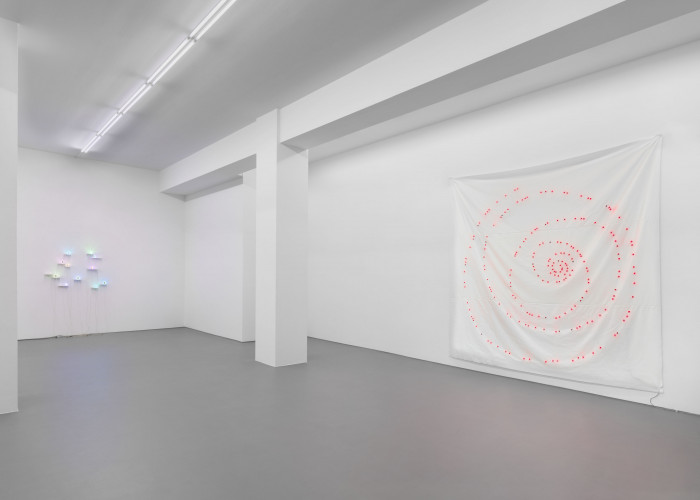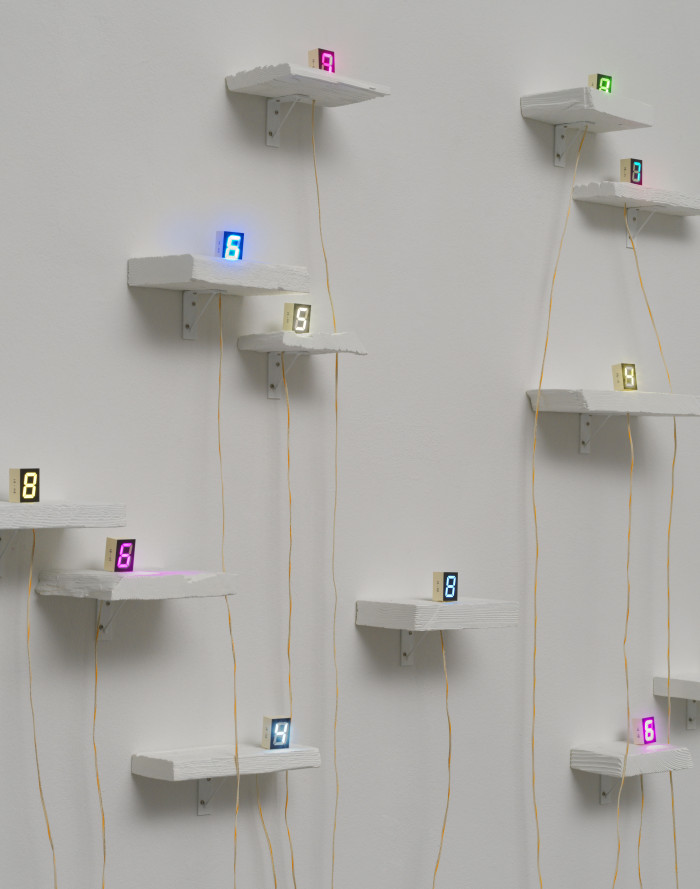
Tatsuo Miyajima Unstable
Buchmann Galerie is pleased to announce the eleventh solo exhibition at the gallery of new works by Japanese artist Tatsuo Miyajima (b. 1957 in Tokyo).
Tatsuo Miyajima is concerned with fundamental questions of time, space, and existence. A significant part of his multifaceted oeuvre comprises works featuring digital light-emitting diodes (LEDs), specially developed by the artist and manufactured for him, whose numerals light up in continuous and repetitive cycles from 1 to 9. For Miyajima, these numerals represent the path from life to death, the finality of which is symbolized by the “0” or zero, which therefore never appears in his works.
For the exhibition Unstable, Tatsuo Miyajima presents works from two new LED-based series of works: Unstable Time and HITEN.
Miyajima uses nylon fabric for the first time as support ground for the newly developed series Unstable Time. The single-color “LED gadgets” are affixed to fabric in a spiral or circular fashion and count in various rhythms. The instability and softness of the fabric, hung freely on the wall, references the impossibility of being able to fully control the world and adds an element of “instability” to the work that oscillates dialectically between uncontrollability and freedom. Time and the universe are not fixed or absolute, but something gently flowing and malleable. The only thing we can do when confronted with such an uncontrollable world is to face the various phenomena with our imagination.
Keep changing, connect with everything, and continue forever are the three conceptual underpinnings of Tatsuo Miyajima’s multifaceted work. The new works from the HITEN series explore these guiding principles with minimalist precision. LEDs are arranged on small, wall-mounted consoles and change color after each countdown cycle. Tatsuo Miyajima sees this as a reference to reincarnation in Buddhism (Samsara); Friedrich Nietzsche’s concept of eternal return (Ewige Wiederkehr) also comes to mind here. The work’s title, Hiten, is a reference to a painted angel inside the Mogao Caves in Dunhuang, China. This angel, donning a vibrantly colored vestment, flies freely in the sky without being controlled by anyone.
The cyclical nature of Tatsuo Miyajima’s work, the constant change that underlies it, invites viewers to reflect and meditate on the “impermanence” or transitoriness of all being.
“New technologies coexist naturally with old traditions in my everyday life,” Tatsuo Miyajima says of the origins of his complex triple jump between Far Eastern philosophy, technology, and contemporary theory. The artist’s latest works applies this research into essential concepts to the instability of contemporary reality. In a world increasingly dominated by numbers and counting, Tatsuo Miyajima’s existential examination of time and numbers is stirringly relevant.
Important works by the artist are represented in the collections of the Tate Gallery London, the Bayerischen Staatsgemäldesammlung Munich, La Caixa Barcelona, Deste Foundation Athens, the Museum of Contemporary Art Chicago, the Museum of Contemporary Art Tokyo, Leeum Seoul, Kunstmuseum Bern, and M+ in Hong Kong.
In the last three years, solo exhibitions have been held at the Minsheng Museum in Shanghai, the Chiba City Museum in Chiba, Japan, the Santa Barbara Museum of Art in California, and the EMMA Museum in Espoo, Finland. The artist’s body of drawings is currently on view in an exhibition at the Städtische Galerie Wolfsburg.
For more information on the artist or images of his work, please feel free to contact the gallery at any time.

Tatsuo Miyajima
Born 1957 in Tokyo. Lives and works in Ibaraki, Japan.
2012 - 2016 Kyoto University of Art & Design Vice President
2006 - 2016 Tohoku University of Art & Design Vice President
| 1986 | Completed postgraduate studies at Tokyo National University of Fine Arts and Music (M.A.) |
| 1984 | Graduated from Oil Painting Course, Fine Arts Department, Tokyo National University of Fine Arts and Music (B.A.) |
| 1998 | London Institute honorary doctorate |
| 1993 | Fondation Cartier pour l'art contemporain, Paris |
| 1990–1991 | DAAD Scholarship Berliner Kunstprogramm Berlin, |
| 1990 | ACC - Asian Cultural Council, New York |
National Museum of Modern Art, Kyoto, Japan
Hara Museum of Contemporary Art, Tokyo, Japan
Museum of Modern Art, Shiga, Japan
Nagoya City Art Museum, Nagoya, Japan
Museum of Contemporary Art, Tokyo, Japan
Panasonic Museum in Osaka, Japan
FARET Tachikawa, Tokyo, Japan
TV Asahi building, Tokyo, Japan
Tokyo Opera City, Tokyo, Japan
Chiba City Museum, Chiba, Japan
Group Home Sala in Florence Village, Akita, Japan
The Museum of Modern Art, Saitama, Japan
Contemporary Art Museum, Kumamoto, Japan
Toyota Municipal Museum of Art, Aichi, Japan
Saitama Prefectural University, Saitama, Japan
Izumi City Plaza, Osaka, Japan
Naoshima Contemporary Art Museum, Kagawa, Japan
Iwaki City Art Museum, Fukushima, Japan
Hiroshima City Museum of Contemporary Art, Hiroshima, Japan
M+ Museum, Hong Kong
Taipei Fine Arts Museum, Taiwan
Samsung Cultural Foundation, Seoul, Korea
Leeum, Samsung Museum, Seoul, Korea
Chinese Telecom, Taipei, China
Tate Gallery, London, UK
The British Museum, London, UK
Deste Foundation for Contemporary Art, Athens, Greece
Fondation Cartier pour l'art contemporain, Paris, France
Kunstmuseum Bern, Bern, Switzerland
Kunstmuseum St. Gallen, Switzerland
Université de Genève, Switzerland
La Caixa, Barcelona, Spain
Pinakothek der Moderne, Munich, Germany
Kunstmuseum Stuttgart, Germany
Fondazione TESECO per l'Arte, Pisa, Italy
Chateau La Coste, Aix-en-Provence, France
Modern Art Museum of Fort Worth, Texas, U.S.A.
San Francisco Museum of Modern Art, San Francisco, U.S.A.
Museum of Contemporary Art, Chicago, U.S.A.
Dallas Museum of Art, U.S.A.
Denver Art Museum, Denver, U.S.A.
Dannheisser Foundation, New York, U.S.A.
National Gallery of Canada, Ottawa, Canada
Oakville Galleries, Oakville, Canada
Australian Museum, Sydney, Australia
| 2005 | ARTISTS SUMMIT, KYOTO, Kyoto University of Art and Design, Kyoto, Japan |
| 2002 | Collaboration with SOPHNET (fashion design brand) 2002 A/W Collection Tokyo 1000 Real Life Project - Death Clock, Tokyo |
| 2000 | Floating Time - Hospice Project, Sotoasahikawa Hospital, Akita |
| 1998 | Portfolio for The Edge of Awareness |
| 1995 | Portfolio for 4. Uluslararasi Istanbul Bienali-ORIENT / ATION |
| 1994 | Mirror, multiple, Spiral, Tokyo |
| 1993 | Over Economy, acrylic, pencil on bank note \10,000 |
| 1992 | Project for PARKETT |
| 1984 | Time Funeral, record jacket, SMS Records |














